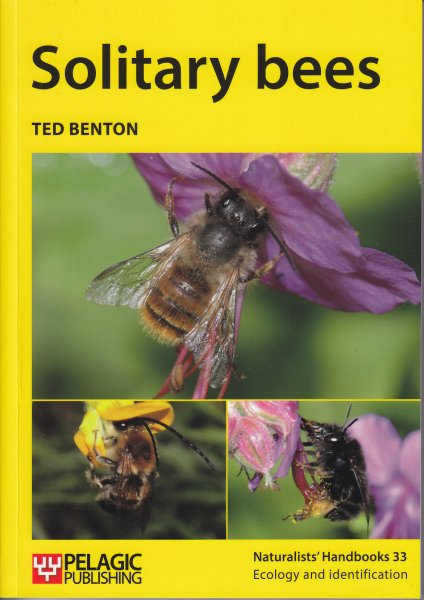
Publisher: Pelagic Publishing, Exeter
Publication Year: 2017
Binding: 1
Page Count: 208
ISBN Number: 9781784270889
Price: £19.99
Solitary Bees
The recent surge in interest in pollinators, partially driven by worries over threats from habitat loss to neonicotinoids and a strong narrative reminding people of their importance to many crops, has undoubtedly helped increase resources for people studying these groups. This helps create a virtuous circle: the more people start getting interested in a taxonomic group, the greater the demand for books and other information. Bees – and those who want to learn about them – seem to be particularly benefitting from the concern over pollinators, and following 2015’s Field Guide to the Bees of Great Britain and Ireland, a couple of books focusing on bumblebees, and Dave Goulson’s excellent books aimed at the general reader, we now have Ted Benton’s Solitary Bees.
This is an interesting and illuminating book. A minor niggle for me was that I found the compressed text layout, standard to Naturalist’s Handbooks, didn’t help make the text easy to read; the margins set aside for figures were rarely used, with most figures interspersed with the text, particularly in later chapters. The decision of the author to mention, but not use, Falk’s English names from the Field Guide, using vernacular names for some species and not others, felt like a missed opportunity – not least to help naturalists communicate with the wider public and encourage more people to care about this group, often ignored in comparison with the bumblebees.
Slightly cheaper than the Field Guide, some who already have books on bumblebees may choose to buy this book rather than the new Field Guide as an introduction to the solitary bee group. It fills this role admirably, but prospective purchasers should note that although it includes a key and introduction to the genera (which I found slightly clearer than the genera key in the Field Guide) it is not an identification or species account book. Instead, the author gives broader insight into the lives, needs and conservation of solitary bees, and encourages people to study them to fill in some of the many knowledge gaps. The contribution “citizen scientists” can make by simply identifying and recording species is rightly celebrated, but it was wonderful to see here emphasis and encouragement for the contributions amateur naturalists can and do make to understanding species’ ecology and behaviour.
If you are interested in learning more about the fascinating lives of solitary bees, this book is worth reading at least once and probably several times to absorb the wealth of information it contains.Book reviewed by Teresa Frost





Share this page